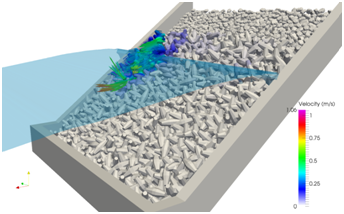Title: Numerical modelling of rubble-mound armour unit stability under storm wave action: The Wave Proxy Tool (WPT)
Speakers: John-Paul Latham, Jiansheng Xiang (Department of Earth Science and Engineering, Imperial College London, UK)
Venue: Meeting Room A301, Institute of Ocean Engineering, State Key Laboratory of Coastal and Offshore Engineering
Time: 09:30 - 10:30, 1st August (Monday), 2016
Abstract:
Sea-level rise and increased storminess present huge challenges to coastal engineers and governments worldwide. The seaward slope of many breakwaters and shoreline defence structures consists of thousands of interlocking units of concrete or rock, making up a massive granular defence against wave attack. The units are placed freely to form an armour layer which is intended to both dissipate wave energy and remain structurally stable through interlock and friction. The two main failure modes for concrete armour layers are displacement (hydraulic instability) and breakage (structural instability) which are often combined. The FEMDEM modelling is ideally suited to address this potentially fragile multi-body scenario for all concrete unit types, or indeed rock blocks. The talk will introduce some of the key points about the numerical modelling technology employed in this work. The challenge tackled by the development of the NWP is to go beyond the dry solid FEMDEM modelling and to introduce oscillatory wave disturbance forces to such solids models with sufficient realism so that useful new numerical model information on armour stability can be used by designers. This is achieved using advanced 3D numerical wave tank simulations of wave-induced fluid flows inside the armour and under layers. Pressure-velocity-time histories of 2D sea states are also modelled enabling longer runs and entire storm sea states to be investigated for the equivalent rubble-mound structure. The correctly calibrated pressure-velocity-time storm history for the entire 3D domain heralds the introduction of the new ‘wave proxy’ method, based on the multi-body solids FEMDEM solver, Solidity, developed at Imperial College London. The integrated surface pressures and water particle velocities acting on units yield the required oscillatory hydraulic and buoyancy forces. These drive the potential instability and movements and are superimposed on each unit in combination with the constantly updated contact, inertia and body forces. The WPT stability results of this ‘one-way’ coupling method will be briefly illustrated for extreme design storm conditions acting on a Core-Loc structure. The talk will conclude with a discussion of the importance of the WPT to the designer.

Dr John-Paul Latham
He was awarded his PhD in Structural Geology, Imperial College London in 1983. Later, he became Director of the MSc in Geomaterials, Queen Mary London University. He returned to Imperial in 1999, where he is now Reader in Geomechanics.
Latham has championed the use of discontinuum solids numerical models to tackle coastal engineering problems in rubble structures, has publishing more than one hundred papers, presented keynotes on modelling breakwaters and on rock fragmentation, and two Royal Society papers. At the 49th US Rock Mechanics / Geomechanics Symposium in San Francisco 2015, he was awarded the annual prize for best Rock Mechanics Research by the American Rock Mechanics Association (ARMA).
Latham is lead author of the 240-page Chapter 3 on materials, for the ‘The Rock Manual: The use of rock in hydraulic engineering’ Second fully revised and extended edition, (having also written sections of the 1991 first edition), C683 CIRIA/CUR/CETMEF, 2007, 1304 pages.
He has been the Principal Investgator on five EPSRC grants, including the £0.91m GGS Project - Modelling forces and stresses in gigantic granular systems for coastal engineers. GGS builds on Latham & Munjiza’s (£0.81m) EPSRC project, VGW (Virtual Geoscience Workbench), renamed Virtual Geoscience Simulation Tools (VGeST) which developed FEMDEM models. Currently he holds several industry funded FEMDEM projects (Baird/Artelia, £180K; itf Oil Company Consortium; Johnson Matthey EPSRC/Case award).He is currently Principal Investigator on work packages in a NERC £513K Waste Repository geomechanics (Hydroframe) modelling project and EU €517K Radial Drilling Geothermal (SURE) project.
Dr. Jiansheng Xiang
He is a Research Fellow in Computational Physics at Imperial College London. He thrives in both the role of model developer, presenting at conferences on computational methods, and in his role interfacing with the needs of industry in applications conferences, e.g. Coastal, Minerals, Powder Technology, working with Engineers in Coastal Structures, Ocean Renewables, Fracture and Fragmentation in Geomaterials, Fluid Flow in Fractured Rock Masses for Oil Reservoir and Geological Disposal of Nuclear Wastes, as well as Particulates and Powder Technology. He is the author of 42 journal publications. He has achieved four modelling breakthroughs, 1) the Eulerian-Lagrangian model; 2) multi-body solids modelling (Finite Element Method combined with Discrete Element Method, FEMDEM); 3) Immersed body method; 4) 3D fracture and plasticity modelling in FEMDEM.